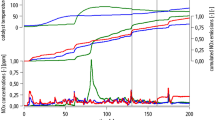Abstract
Optimal control of the exhaust aftertreatment components is an important aspect for minimizing pollutants. Nitrogen oxides are therefore monitored using amperometric gas sensors. However, they show marked cross-sensitivities to ammonia, which can be disadvantageous, e.g., if they are applied in NH3 selective catalytic reduction systems. In this study, a model that simulates the operation of a NOx sensor is developed. The three oxygen pumping cells and the upstream diffusion barriers were implemented in a 1D geometry, with the relevant electrode reactions taking place over its length. The diffusion barriers were calculated quasi-stationary. The dynamics of incoming gas components as a function of the exhaust mass flow were integrated with a first order linear time invariant system. The problem was calculated using the convection–diffusion equation. The reaction kinetics were determined based on stationary measurements in laboratory atmosphere, whereby initially only the reaction with respect to NO and NO2 was considered. Then, the cross-sensitivities to oxygen, water and ammonia were examined. The developed data set could then be used for transient boundary conditions. The simulated and the measured sensor signals in the case of engine test bench conditions with real driving cycles agree very well.






Similar content being viewed by others
References
Koebel M, Elsener M, Kleemann M (2000) Urea-SCR: a promising technique to reduce NOx emissions from automotive diesel engines. Catal Today 59(3–4):335–345
Nova I, Castoldi L, Lietti L et al (2007) How to control the selectivity in the reduction of NOx with H2 over Pt–Ba/Al2O3 Lean NOx Trap catalysts. Top Catal 42–43(1–4):21–25
Posada F, Bandivadekar A (2015) Global overview of on-board diagnostics (OBD) systems for heavy-duty vehicles. The International Council on Clean Transportation (ICCT). http://theicct.org/sites/default/files/publications/ICCT_Overview_OBD-HDVs_20150209.pdf. Accessed 9 June 2017
Y Le Wang, Kolmanovsky I, Sun J Online identification and adaptation of LNT models for improved emission control in lean burn automotive engines. In: Proceedings of 2000 American control conference. https://doi.org/10.1109/ACC.2000.876652
Ericson C, Westerberg B, Andersson M et al (2006) Modelling diesel engine combustion and NOx formation for model based control and simulation of engine and exhaust aftertreatment systems. In: SAE world congress and exhibition 2006. https://doi.org/10.4271/2006-01-0687
Herman A, Wu M, Cabush D et al (2009) Model based control of SCR dosing and OBD strategies with feedback from NH3 sensors. SAE Int J Fuels Lubr 2(1):375–385. https://doi.org/10.4271/2009-01-0911
Devarakonda M, Parker G, Johnson JH et al (2009) Model-based estimation and control system development in a urea-SCR aftertreatment system. SAE Int J Fuels Lubr 1(1):646–661
Kato N, Nakagaki K, Ina N (1996) Thick film ZrO2 NOx sensor for the measurement of low NOx concentration. SAE Technical Paper 960334. https://doi.org/10.4271/960334
Frobert A, Raux S, Creff Y et al (2013) About cross-sensitivities of NOx sensors in SCR operation. SAE Technical Paper 2013-01-1512. https://doi.org/10.4271/2013-01-1512
Brailsford AD, Yussouff M, Logothetis EM (1997) A first-principles model of the zirconia oxygen sensor. Sens Actuators B 44(1–3):321–326
López-Gándara C, Ramos FM, Cirera A et al (2009) A model of the behavior of the limiting current oxygen sensors. Sens Actuators B 140(2):432–438
Aliramezani M, Koch CR, Hayes RE et al (2017) Amperometric solid electrolyte NOx sensors—the effect of temperature and diffusion mechanisms. Solid State Ion 313:7–13
Aliramezani M, Koch CR, Patrick R (2018) Phenomenological model of a solid electrolyte NOx and O2 sensor using temperature perturbation for on-board diagnostics. Solid State Ion 321:62–68
Cussler EL (1976) Multicomponent diffusion. Elsevier Science, Burlington
Millington RJ (1959) Gas diffusion in porous media. Science 130(3367):100–102
Bard AJ, Inzelt G, Scholz F (2008) Electrochemical dictionary. Springer, Berlin
Baliga BR, Patankar SV (1980) A new finite-element formulation for convection–diffusion problems. Numer Heat Transf 3(4):393–409
Mitterdorfer A, Gauckler LJ (1999) Identification of the reaction mechanism of the Pt, O2 (g)|yttria-stabilized zirconia system—Part II: model implementation, parameter estimation, and validation. Solid State Ion 117(3–4):203–217
Author information
Authors and Affiliations
Corresponding author
Rights and permissions
About this article
Cite this article
Ritter, T., Seibel, M., Hofmann, F. et al. Simulation of a NOx Sensor for Model-Based Control of Exhaust Aftertreatment Systems. Top Catal 62, 150–156 (2019). https://doi.org/10.1007/s11244-018-1102-3
Published:
Issue Date:
DOI: https://doi.org/10.1007/s11244-018-1102-3




